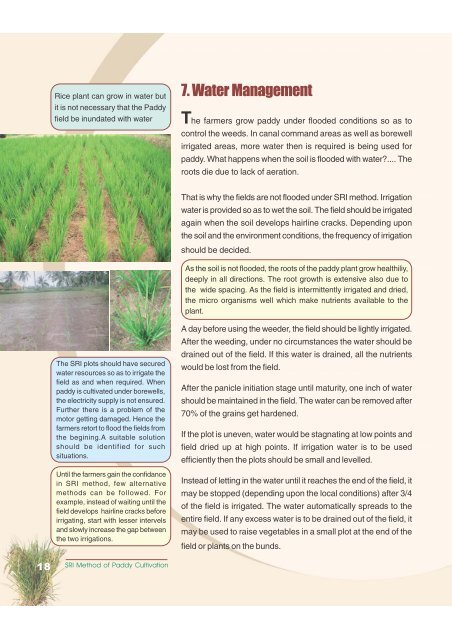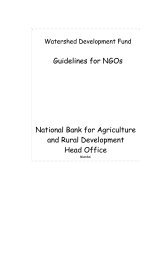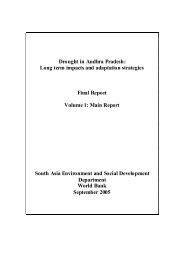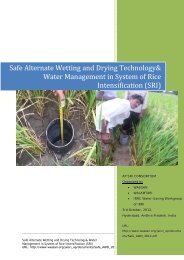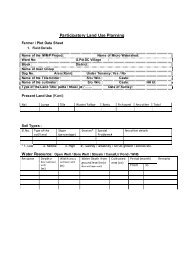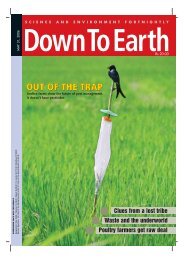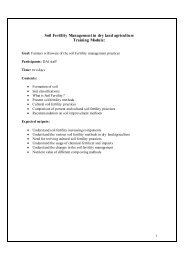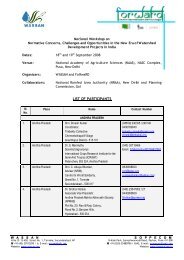SRI Method of Paddy Cultivation - WASSAN
SRI Method of Paddy Cultivation - WASSAN
SRI Method of Paddy Cultivation - WASSAN
You also want an ePaper? Increase the reach of your titles
YUMPU automatically turns print PDFs into web optimized ePapers that Google loves.
Rice plant can grow in water but<br />
it is not necessary that the <strong>Paddy</strong><br />
field be inundated with water<br />
The <strong>SRI</strong> plots should have secured<br />
water resources so as to irrigate the<br />
field as and when required. When<br />
paddy is cultivated under borewells,<br />
the electricity supply is not ensured.<br />
Further there is a problem <strong>of</strong> the<br />
motor getting damaged. Hence the<br />
farmers retort to flood the fields from<br />
the begining.A suitable solution<br />
should be identified for such<br />
situations.<br />
Until the farmers gain the confidance<br />
in <strong>SRI</strong> method, few alternative<br />
methods can be followed. For<br />
example, instead <strong>of</strong> waiting until the<br />
field develops hairline cracks before<br />
irrigating, start with lesser intervels<br />
and slowly increase the gap between<br />
the two irrigations.<br />
18 <strong>SRI</strong> <strong>Method</strong> <strong>of</strong> <strong>Paddy</strong> <strong>Cultivation</strong><br />
7. Water Management<br />
The farmers grow paddy under flooded conditions so as to<br />
control the weeds. In canal command areas as well as borewell<br />
irrigated areas, more water then is required is being used for<br />
paddy. What happens when the soil is flooded with water?.... The<br />
roots die due to lack <strong>of</strong> aeration.<br />
That is why the fields are not flooded under <strong>SRI</strong> method. Irrigation<br />
water is provided so as to wet the soil. The field should be irrigated<br />
again when the soil develops hairline cracks. Depending upon<br />
the soil and the environment conditions, the frequency <strong>of</strong> irrigation<br />
should be decided.<br />
As the soil is not flooded, the roots <strong>of</strong> the paddy plant grow healthiliy,<br />
deeply in all directions. The root growth is extensive also due to<br />
the wide spacing. As the field is intermittently irrigated and dried,<br />
the micro organisms well which make nutrients available to the<br />
plant.<br />
A day before using the weeder, the field should be lightly irrigated.<br />
After the weeding, under no circumstances the water should be<br />
drained out <strong>of</strong> the field. If this water is drained, all the nutrients<br />
would be lost from the field.<br />
After the panicle initiation stage until maturity, one inch <strong>of</strong> water<br />
should be maintained in the field. The water can be removed after<br />
70% <strong>of</strong> the grains get hardened.<br />
If the plot is uneven, water would be stagnating at low points and<br />
field dried up at high points. If irrigation water is to be used<br />
efficiently then the plots should be small and levelled.<br />
Instead <strong>of</strong> letting in the water until it reaches the end <strong>of</strong> the field, it<br />
may be stopped (depending upon the local conditions) after 3/4<br />
<strong>of</strong> the field is irrigated. The water automatically spreads to the<br />
entire field. If any excess water is to be drained out <strong>of</strong> the field, it<br />
may be used to raise vegetables in a small plot at the end <strong>of</strong> the<br />
field or plants on the bunds.


